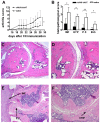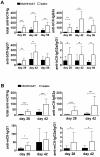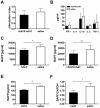Alpha-1 antitrypsin protein and gene therapies decrease autoimmunity and delay arthritis development in mouse model
- PMID: 21345239
- PMCID: PMC3050720
- DOI: 10.1186/1479-5876-9-21
Alpha-1 antitrypsin protein and gene therapies decrease autoimmunity and delay arthritis development in mouse model
Abstract
Background: Alpha-1 antitrypsin (AAT) is a multi-functional protein that has anti-inflammatory and tissue protective properties. We previously reported that human AAT (hAAT) gene therapy prevented autoimmune diabetes in non-obese diabetic (NOD) mice and suppressed arthritis development in combination with doxycycline in mice. In the present study we investigated the feasibility of hAAT monotherapy for the treatment of chronic arthritis in collagen-induced arthritis (CIA), a mouse model of rheumatoid arthritis (RA).
Methods: DBA/1 mice were immunized with bovine type II collagen (bCII) to induce arthritis. These mice were pretreated either with hAAT protein or with recombinant adeno-associated virus vector expressing hAAT (rAAV-hAAT). Control groups received saline injections. Arthritis development was evaluated by prevalence of arthritis and arthritic index. Serum levels of B-cell activating factor of the TNF-α family (BAFF), antibodies against both bovine (bCII) and mouse collagen II (mCII) were tested by ELISA.
Results: Human AAT protein therapy as well as recombinant adeno-associated virus (rAAV8)-mediated hAAT gene therapy significantly delayed onset and ameliorated disease development of arthritis in CIA mouse model. Importantly, hAAT therapies significantly reduced serum levels of BAFF and autoantibodies against bCII and mCII, suggesting that the effects are mediated via B-cells, at least partially.
Conclusion: These results present a new drug for arthritis therapy. Human AAT protein and gene therapies are able to ameliorate and delay arthritis development and reduce autoimmunity, indicating promising potential of these therapies as a new treatment strategy for RA.
Figures






Similar articles
-
Combination of alpha-1 antitrypsin and doxycycline suppresses collagen-induced arthritis.J Gene Med. 2010 Jan;12(1):35-44. doi: 10.1002/jgm.1409. J Gene Med. 2010. PMID: 19866480
-
In Vivo Analysis of Alpha-1-Antitrypsin Functions in Autoimmune Disease Models.Methods Mol Biol. 2018;1826:143-155. doi: 10.1007/978-1-4939-8645-3_10. Methods Mol Biol. 2018. PMID: 30194599
-
Vaccination with an immunodominant peptide of bovine type II collagen induces an anti-TCR response, and modulates the onset and severity of collagen-induced arthritis.Int Immunol. 2004 May;16(5):737-45. doi: 10.1093/intimm/dxh075. Epub 2004 Mar 29. Int Immunol. 2004. PMID: 15096482
-
Transplantation of Adipose Tissue-Derived Mesenchymal Stem Cell (ATMSC) Expressing Alpha-1 Antitrypsin Reduces Bone Loss in Ovariectomized Osteoporosis Mice.Hum Gene Ther. 2017 Feb;28(2):179-189. doi: 10.1089/hum.2016.069. Epub 2016 Nov 1. Hum Gene Ther. 2017. PMID: 27802778 Review.
-
Preclinical models of arthritis for studying immunotherapy and immune tolerance.Ann Rheum Dis. 2021 Oct;80(10):1268-1277. doi: 10.1136/annrheumdis-2021-220043. Epub 2021 Aug 11. Ann Rheum Dis. 2021. PMID: 34380700 Free PMC article. Review.
Cited by
-
Alpha-1-Antitrypsin Ameliorates Pristane Induced Diffuse Alveolar Hemorrhage in Mice.J Clin Med. 2019 Aug 29;8(9):1341. doi: 10.3390/jcm8091341. J Clin Med. 2019. PMID: 31470606 Free PMC article.
-
Circulating Truncated Alpha-1 Antitrypsin Glycoprotein in Patient Plasma Retains Anti-Inflammatory Capacity.J Immunol. 2019 Apr 15;202(8):2240-2253. doi: 10.4049/jimmunol.1801045. Epub 2019 Feb 22. J Immunol. 2019. PMID: 30796179 Free PMC article. Clinical Trial.
-
Low Levels of IgG Recognizing the α-1-Antitrypsin Peptide and Its Association with Taiwanese Women with Primary Sjögren's Syndrome.Int J Mol Sci. 2017 Dec 18;18(12):2750. doi: 10.3390/ijms18122750. Int J Mol Sci. 2017. PMID: 29258281 Free PMC article.
-
Potential Use of Alpha-1 Anti-trypsin in the Covid-19 Treatment.Front Cell Dev Biol. 2020 Oct 23;8:577528. doi: 10.3389/fcell.2020.577528. eCollection 2020. Front Cell Dev Biol. 2020. PMID: 33195215 Free PMC article. No abstract available.
-
Role of alpha-1 antitrypsin in Bruch's membrane integrity.Sci Rep. 2025 Apr 10;15(1):12223. doi: 10.1038/s41598-025-96570-x. Sci Rep. 2025. PMID: 40210893 Free PMC article.
References
Publication types
MeSH terms
Substances
Grants and funding
LinkOut - more resources
Full Text Sources
Other Literature Sources
Medical
Research Materials
Miscellaneous

